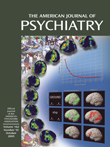fMRI Study of Maintenance and Manipulation Processes Within Working Memory in First-Episode Schizophrenia
Abstract
OBJECTIVE: Working memory, a critical cognitive capacity that is affected in schizophrenia, can be divided into maintenance and manipulation processes. Previous behavioral research suggested that manipulation is more affected than maintenance in patients with chronic schizophrenia. In this study of first-episode schizophrenia patients, the authors evaluated the extent to which the two working memory processes are affected early in the course of schizophrenia. METHOD: Study subjects were 11 first-episode schizophrenia patients and 11 matched healthy comparison subjects. Each group performed two verbal working memory tasks while undergoing functional magnetic resonance imaging. One task required maintenance of information; the other required manipulation of information in addition to maintenance. RESULTS: Under behaviorally matched conditions, both groups activated a predominantly left-sided frontal-parietal network. The manipulation plus maintenance task elicited activation of greater magnitude and spatial extent. With both tasks, patients showed less bilateral dorsolateral prefrontal cortex activation and greater ventrolateral prefrontal cortex activation, relative to the comparison subjects. A group-by-task interaction was observed for activation at the left dorsolateral and ventrolateral prefrontal cortex. The increase in activation when patients engaged in the manipulation plus maintenance task was disproportionately less in the dorsolateral prefrontal cortex and greater in the ventrolateral prefrontal cortex. CONCLUSIONS: These functional neuroanatomical findings add support to earlier suggestions that manipulation of information is selectively more affected than maintenance of information in persons with schizophrenia. They also suggest the presence of interacting regions of dysfunctional and compensatory prefrontal responses in the dorsolateral and ventrolateral prefrontal cortex, respectively, that are more prominent when information is manipulated. This disrupted prefrontal network is present relatively early in the course of schizophrenia.



